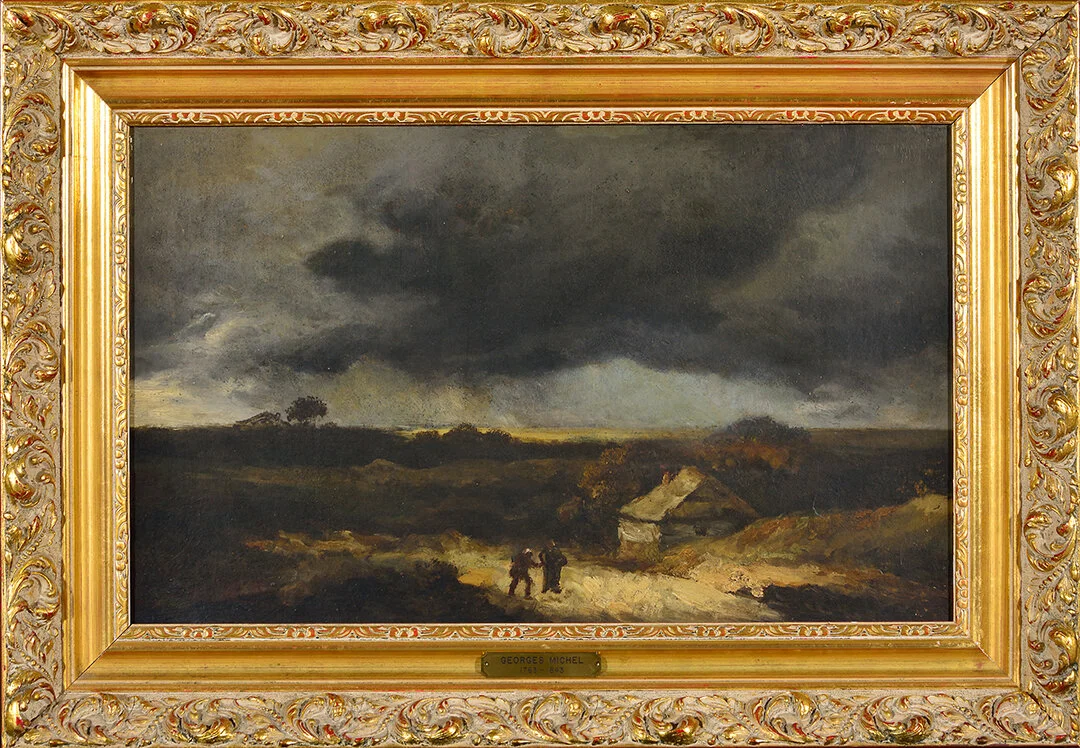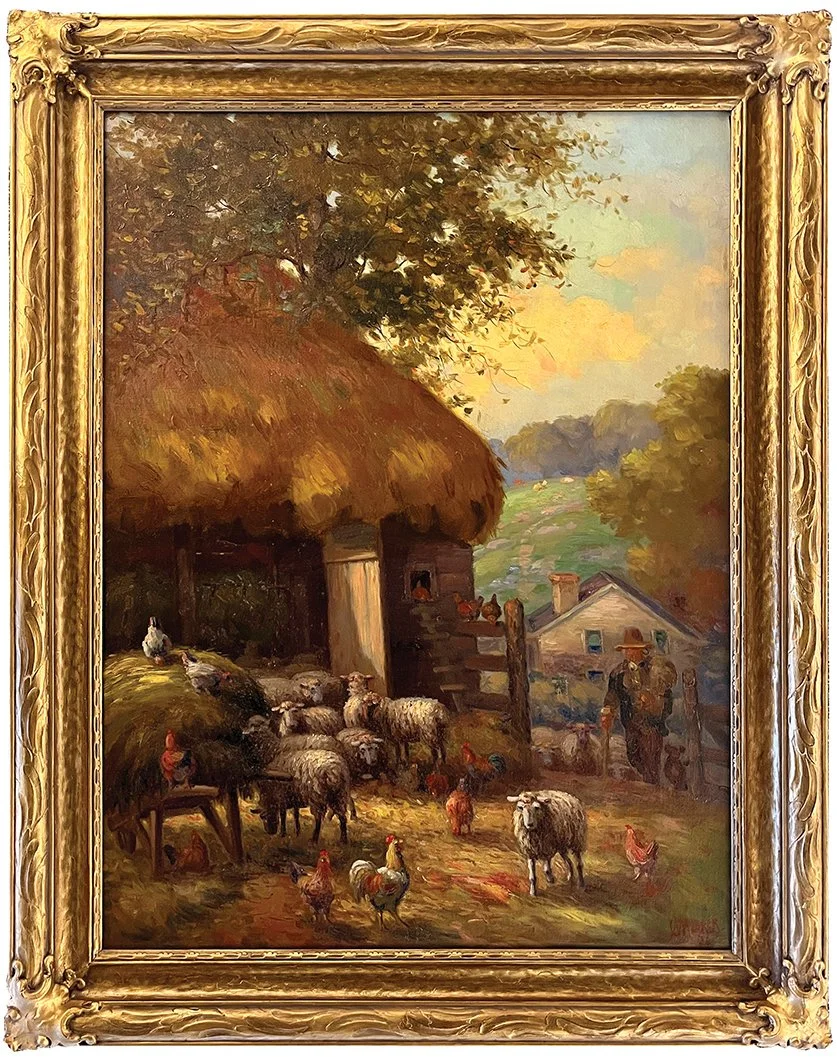Edward Lear
Edward Lear
Mountain Pass Scene - Greece, 1857
Watercolor
14 x 19 inches
Unsigned
ID: DH274
Edward Lear (12 May 1812 - 29 January 1888) was an English artist, illustrator, author, and poet, renowned today primarily for his literary nonsense, in poetry and prose, and especially his limericks, a form that he popularized.
Lear was born into a middle-class family in the village of Holloway, the 21st child of Ann and Jeremiah Lear. He was raised by his eldest sister, also named Ann, 21 years his senior. A nn doted on Lear and continued to mother him until her death, when Lear was almost 50 years of age. Due to the family's failing financial fortune, at age four he and his sister had to leave the family home and set up house together.
Lear suffered from health problems. From the age of six he suffered frequent grand mal epileptic seizures, and bronchitis, asthma, and in later life, partial blindness. Lear experienced his first seizure at a fair near Highgate with his father. The event scared and embarrassed him. Lear felt lifelong guilt and shame for his epileptic condition. His adult diaries indicate that he always sensed the onset of a seizure in time to remove himself from public view. How Lear was able to anticipate them is not known, but many people with epilepsy report a ringing in their ears or an "aura" before the onset of a seizure. In Lear's time epilepsy was believed to be associated with demonic possession, which contributed to his feelings of guilt and loneliness. When Lear was about seven, he began to show signs of depression, possibly due to the constant instability of his childhood. He suffered from periods of severe depression which he referred to as "the Morbids."
Lear traveled widely throughout his life and eventually settled in Sanremo, on his beloved Mediterranean coast, in the 1870s, at a villa he named "Villa Tennyson." The closest he came to marriage was two proposals, both to the same woman 46 years his junior, which were not accepted. For companions he relied instead on a circle of friends and correspondents, and especially, in later life, on his Suliot chef, Giorgis, a faithful friend and, as Lear complained, a thoroughly unsatisfactory chef. Another trusted companion in Sanremo was his cat, Foss, who died in 1886 and was buried with some ceremony in a garden at Villa Tennyson.
After a long decline in his health, Lear died at his villa in 1888, of the heart disease from which he had suffered since at least 1870. Lear's funeral was said to be a sad, lonely affair by the wife of Dr. Hassall, Lear's physician, not one of Lear's many lifelong friends being able to attend.
Lear is buried in the Foce Cemetery in Sanremo. On his headstone are inscribed these lines from Tennyson's To E.L. [Edward Lear], On His Travels in Greece:
... all things fair.? With such a pencil, such a pen.? You shadow forth to distant men,? I read and felt that I was there.
?Edward Lear was known to introduce himself with his long name: "Mr Abebika kratoponoko Prizzikalo Kattefello Ablegorabalus Ableborinto phashyph" or "Chakonoton the Cozovex Dossi Fossi Sini Tomentilla Coronilla Polentilla Battledore & Shuttlecock Derry down Derry Dumps" which he based on Aldiborontiphoskyphorniostikos.
Lear was already drawing "for bread and cheese" by the time he was aged 16 and soon developed into a serious "ornithological draughtsman" employed by the Zoological Society and then from 1832-36 by the Earl of Derby, who had a private menagerie. His first publication, published when he was 19, was Illustrations of the Family of Psittacidae, or Parrots in 1830. His paintings were well received and he was favourably compared with John James Audubon.
Lear travelled for three years in Italy from 1837, and published two volumes of illustrations, Illustrated Excursions in Italy, the first of many such books. Lear briefly gave drawing lessons to Queen Victoria, who had been pleased by the Excursions and summoned him to Court, leading to some awkward incidents when he failed to observe proper court protocol. Lear then returned to the Mediterranean, wishing to illustrate all points along the coast of that sea.
Among other trips, he visited Greece and Egypt in 1848-49, and toured the length of India and Ceylon in 1873-75. While traveling he produced large quantities of coloured wash drawings in a distinctive style, which he worked up back in his studio into oils and watercolours, as well as prints for his books. His landscape style often shows views with strong sunlight, with intense contrasts of colour.
Throughout his life he continued to paint seriously. He had a lifelong ambition to illustrate Tennyson's poems; near the end of his life a volume with a small number of illustrations was published, but his vision for the work was never realized.
In 1846 Lear published A Book of Nonsense, a volume of limericks that went through three editions and helped popularize the form. In 1865, The History of the Seven Families of the Lake Pipple-Popple was published, and in 1867 his most famous piece of nonsense, The Owl and the Pussycat, which he wrote for the children of his patron Edward Stanley, 13th Earl of Derby. Many other works followed.
Lear's nonsense books were quite popular during his lifetime, but a rumor circulated that "Edward Lear" was merely a pseudonym, and the books' true author was the man to whom Lear had dedicated the works, his patron the Earl of Derby. Supporters of this rumor offered as evidence the facts that both men were named Edward, and that "Lear" is an anagram of "Earl".
Lear's nonsense works are distinguished by a facility of verbal invention and a poet's delight in the sounds of words, both real and imaginary. A stuffed rhinoceros becomes a "diaphanous doorscraper". A "blue Boss-Woss" plunges into "a perpendicular, spicular, orbicular, quadrangular, circular depth of soft mud". His heroes are Quangle-Wangles, Pobbles, and Jumblies. His most famous piece of verbal invention, a "runcible spoon" occurs in the closing lines of The Owl and the Pussycat, and is now found in many English dictionaries:
"They dined on mince, and slices of quince? Which they ate with a runcible spoon;? And hand in hand, on the edge of the sand,? They danced by the light of the moon,? The moon,? The moon,? They danced by the light of the moon."
Five of Lear's limericks from The Book of Nonsense, in the 1946 Italian translation by Carlo Izzo, were set to music for choir a cappella by Goffredo Petrassi, in 1952.
Biography taken from Askart.com





